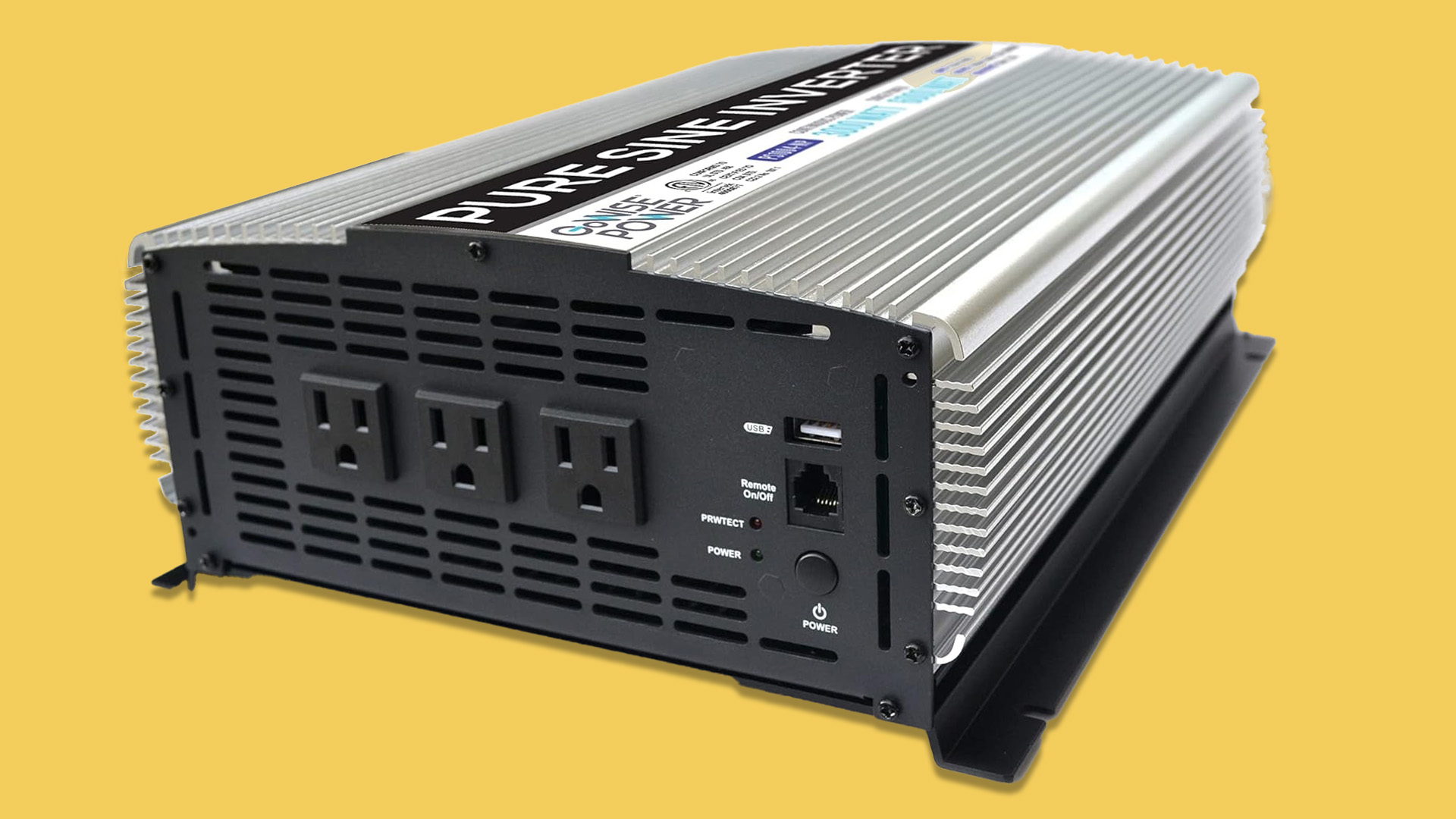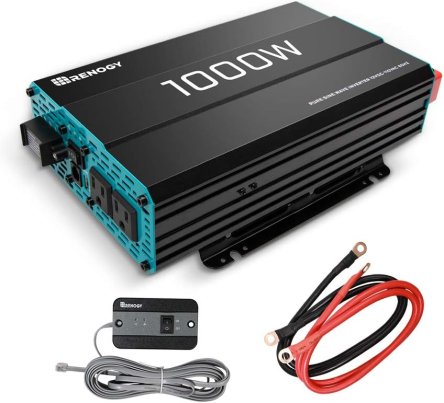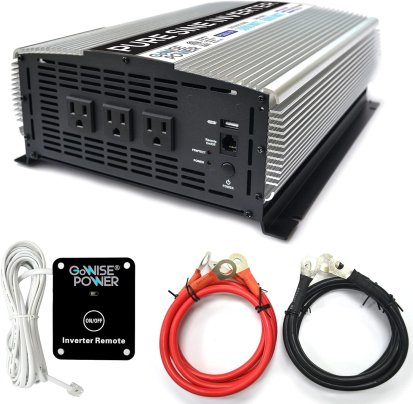We may earn revenue from the products available on this page and participate in affiliate programs. Learn more ›

Whether you’re loading up your RV for a weekend away or starting a van life adventure, pure sine wave inverters help us create our home away from home. If you need to keep something ice cold in a freezer or nuke it in a microwave, a pure sine wave inverter ensures that your devices will work safely. Inverters provide clean, smooth, safe energy to your appliances and reduce the noise associated with running electronics directly from a power source. I’ve created a buying guide so you know what to look out for before picking the right inverter for you. You’ll also find a list of all the best inverters on the market ranked under various categories below.
Summary List
- Best Overall: Renogy 1,000W Pure Sine Wave Inverter
- Best Value: Bestek Power Inverter 1,200W
- Honorable Mention: GoWise Power PS1004 3,000W Inverter
- Best Value 3,000 Watt: Krieger 3,000 Watt Power Inverter
- Best Multi-Use 2,000 Watt: Renogy 2,000W Pure Sine Wave Inverter
- Best Compact: Bestek 500W Pure Sine Wave Power Inverter
Our Methodology
To choose the best pure sine wave inverters on the market, I employed The Drive’s comprehensive research methodology and evaluated dozens of inverters before choosing the top contenders. Although I haven’t personally tested these products, my selection is informed by consumer testimonials, expert reviews, discussions on relevant online forums, and my institutional knowledge of the automotive industry.
I visited the Car Talk and Van Dwellers subreddit to get a more informed opinion of what automotive enthusiasts felt about the products on the market.
Some brands are already well-established in this niche, and priority was given to their products. However, other lesser-known brands were also evaluated. The main features taken into consideration were continuous power wattage, peak power wattage, power sources, power outlets, warranty, price, and reliability. Inverters were immediately disqualified from consideration if they were unreliable or had faults that made them dangerous to use.
Best Pure Sine Wave Inverter Reviews & Recommendations
Best Overall: Renogy 1,000W Pure Sine Wave Inverter
The Renogy 1,000W Pure Sine Wave Inverter will be enough for most people’s needs and serve them well for years to come. Unless you’re going to power several major electrical appliances, this model’s 1,000-watt continuous output and 2,000-watt peak output should suffice. It has a conversion efficiency of around 90 percent and is loaded with safety features, including under/over-voltage protection, over-temperature protection, overload protection, and short-circuit indicators. It’s ETL-certified, so you can rest assured that your appliances are in safe hands.
There’s a built-in 5V/2.1A USB port, two AC outlets, and an AC terminal block. If you choose this inverter, you’ll also get two 3-foot 4-AWG cables and a 19.8-foot wired remote control. You can get a higher-wattage pure sine wave inverter for less money, but this model’s reliability warrants its slightly high price.
Best Value: Bestek Power Inverter 1,200W
In terms of watts for money, it’s hard to beat the Bestek Power Inverter 1,200W as this model has a 1,200-watt continuous output. The manufacturer doesn’t list this product’s peak output but the user’s manual indicates that the overload protection feature is triggered between 1,200 to 1,700-watts. There are two USB quick-charging ports and dual 110V AC outlets, which can be used to power larger devices like laptops, and an LCD screen on the front shows the input/output voltage, and output power.
There’s a smart cooling fan that automatically adjusts its power depending on the inverter’s power load and temperatures, protecting it from overheating. The inverter is ETL-certified and has a range of protection features to keep your devices safe, including under/over-voltage, overload, and short-circuit protection. Included in the sale are four 50A fuses and two battery clamps. You’ll be able to buy with confidence, thanks to the manufacturer’s 18-month warranty.
Honorable Mention: GoWise Power PS1004 3,000W Inverter
If money is no object, and you want the best of the best, check out the GoWise Power PS1004 3,000W Inverter. This model is rated for 3,000 watts of continuous power and has a peak power output of 6,000 watts. Since it has such a high continuous power output, you’ll be able to power plenty of appliances simultaneously, and keeping all your devices safe are five protection systems: thermal, overload, over-voltage, under-voltage, and low-voltage protection. It has a soft start function and cooling fans for temperature control.
There are three standard American outlet sockets and one 2.1A USB port. Although this model has more outlet sockets than most other inverters on the market, it’d be nice to see another USB port. Two 3-foot battery cables and a wired remote control are included in the sale. Since this unit costs considerably more than the rest of the products on this list, it’s only worth purchasing if you think you’ll need plenty of power.
Best Value 3,000 Watt: Krieger 3,000 Watt Power Inverter
For out and out power, but on a bit of a budget, then consider the Krieger 3,000 Watt Power Inverter. This unit has a 3000-watt continuous power output and a peak power output of 6,000 watts. It comes with two 3-foot battery cables and a wired remote control, and there’s also a built-in hardwired kit suitable for applications larger than 15 amps, and keeping everything cool is an ultra-silent fan. You can power your devices via the two 110V power outlets and dual 2.1A USB ports.
For the amount of power on offer, this product is exceptionally good value and you don’t need to worry about reliability, as it’s been tested, validated, and approved by METLAB for both safety and performance and is ETL-certified. Krieger stands by its product too and offers a three-year parts and labor warranty. Whether you’re powering a laptop or a refrigerator, it’ll be protected thanks to this inverter’s smart protection chip. The inverter is protected from overload, under/over-voltage, high temperature, and short-circuiting. This model is best suited for use with an RV or large van as it’s big, weighing 9.1 pounds and measuring 13.75 x 7.62 x 3.37 inches.
Best Multi-Use 2,000 Watt: Renogy 2,000W Pure Sine Wave Inverter
If you need to power multiple appliances or something with a high surge output, check out the Renogy 2,000W Pure Sine Wave Inverter. This model has a conversion efficiency rate of 90 percent, a 2,000-watt continuous power rating, and a 4,000-watt peak power rating during startup. A range of features keeps your devices safe, including under/over-voltage protection, over-temperature protection, overload protection, and a short-circuit indicator. The inverter has a 5V/2.1A USB port, three AC outlets, and one AC terminal block.
Included in the sale are two three-foot 4-AWG cables and a 19.8-foot wired remote control. Like all Renogy inverters, this model is ETL-certified and comes with a one-year warranty. Two high-speed ventilation fans protect this model from overheating and operate relatively quietly. The only negative aspects worth mentioning are that it’s on the high end of the price spectrum and only has one USB outlet.
Best Compact: Bestek 500W Pure Sine Wave Power Inverter
The Bestek 500W Pure Sine Wave Power Inverter is a good option for people who need a portable way to create clean power. It measures 8.7 x 4.3 x 2.4 inches and weighs just 2.2 pounds, so you could easily carry it in a backpack or keep it in your glove box. This model can maintain a constant power output of 500 watts, although the manufacturer doesn’t state what its peak power output is. Relatively speaking, 500 watts isn’t a lot, but it’s plenty for powering a couple of low-energy-needing devices.
The inverter features two regular American outlet sockets and two 2.4A USB ports, and you can pull power from the car’s battery via the cigarette lighter socket or directly clamp the included alligator battery clamps to the battery terminals. If you choose to draw power through the cigarette lighter socket, then keep the wattage under 150, as this is what most vehicles’ fuses are set up for. Speaking of fuses, two spares are included in the sale. All things considered, this product is great value for money.
Our Verdict on Pure Sine Wave Inverters
I’ve chosen the Renogy 1,000W Pure Sine Wave Inverter as the best overall pure sine wave inverter. This model has plenty of power without being overkill, and it’s as reliable as they come. If you’re on a tight budget, check out the value option, the Bestek Power Inverter 1,200W.
What to Consider When Buying a Pure Sine Wave Inverter
There are plenty of features to consider before picking the right pure sine wave inverter for you. I’ve put together a buying guide detailing the different types, features, and brands to consider before making your purchase. Keep reading to find out what features matter to you.
Types of Pure Sine Wave Inverters
Pure Sine Waves
Pure sine waves have a smooth and continuous wave-form with a uniform phase angle that allows for constant and clean output voltage, which rises and falls evenly and instantly changes polarity as it crosses the zero-volt line.
Modified Sine Waves
These sine waves are choppy, and their voltage rises and falls abruptly. Phase angles are sharper and less uniform, causing a rougher, less predictable delivery of voltage. Changes between polarity at the zero-voltage line aren’t instantaneous, but take some time to occur, leaving gaps in the delivery of power to your electronics and appliances.
Pure Sine Wave Inverter Key Features
Continuous Power
The most important thing to consider when buying a pure sine wave power inverter is its continuous power output. The continuous power output should be double what your appliances draw. For example, if you want to run a 150-watt TV, then you’ll need an inverter that’s at least 300 watts. If you plan on using multiple devices simultaneously, then you’ll need to add up the total draw and multiply it by two to see how much continuous power you’ll need.
Peak Power
Continuous power relates to long-term normal wattage operation, while peak power relates to the maximum wattage output that an inverter can supply for a very short period. Many power inverters have a peak power rating, also called peak surge power, which is double the figure of their continuous power output. So, for example, a 3,000-watt inverter could have a peak power output of 6,000 watts. An appliance where peak surge power could be an issue is a refrigerator. To continuously run a refrigerator, you need around 800 watts but, once the compressor starts, it requires another 1,200 surge watts. So an inverter running a refrigerator like this would need a peak power output of 2,000 watts.
Power Outlets
Different pure sine wave inverters will have different power outlets. So you’ll need to think about what kind of devices you usually power and what outlets they require. For example, some models will have three standard American outlets but only one USB port, whereas other inverters might have more USB ports but fewer standard outlets.
Safety Features
The whole point of using a pure sine wave inverter is to safely power your devices. These products come with a host of safety features to keep your devices safe. Here are the most important protective features to look out for: thermal, overload, over-voltage, under-voltage, low-voltage, and short-circuit protection.
Power Source
The majority of pure sine wave inverters come with cables that connect directly to your battery terminals. But some, usually smaller, inverters come with a cable that allows you to draw power from your vehicle’s cigarette lighter socket. So, if you plan on using your inverter while you’re in the car and on the move, you should make sure it comes with a cigarette lighter socket connection.
FAQs on Pure Sine Wave Inverters
You’ve got questions. The Drive has answers!
Q: Do you really need a pure sine wave inverter?
A: If the device or appliance you’re using uses an AC motor then you should probably use a pure sine wave inverter. Examples of devices that need a pure sine wave inverter are refrigerators, compressors, and microwave ovens.
Q: What size pure sine wave inverter do I need?
A: You need a pure sine wave inverter that will cover your appliances’ peak and continuous power needs. Your inverter needs to have a continuous power output that’s double the amount that appliances draw from it. For example, if you use an appliance that continuously draws 200 watts, you’ll need a pure sine wave inverter that has a 400-watt continuous output.
Q: Should I leave my inverter on all the time?
A: Some inverters can be left on at all times, while others should be turned off when they’re not in use. Check what the manufacturer recommends for your particular model. But, even if you can leave your inverter on all the time, it’s good to switch it off from time to time to give its components a rest, especially its fans.









